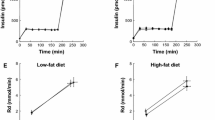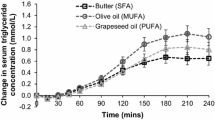Abstract
Purpose
To determine substrate oxidation responses to saturated fatty acid (SFA)-rich meals before and after a 7-day polyunsaturated fatty acid (PUFA)-rich diet versus control diet.
Methods
Twenty-six, normal-weight, adults were randomly assigned to either PUFA or control diet. Following a 3-day lead-in diet, participants completed the pre-diet visit where anthropometrics and resting metabolic rate (RMR) were measured, and two SFA-rich HF meals (breakfast and lunch) were consumed. Indirect calorimetry was used to determine fat oxidation (Fox) and energy expenditure (EE) for 4 h after each meal. Participants then consumed a PUFA-rich diet (50 % carbohydrate, 15 % protein, 35 % fat, of which 21 % of total energy was PUFA) or control diet (50 % carbohydrate, 15 % protein, 35 % fat, of which 7 % of total energy was PUFA) for the next 7 days. Following the 7-day diet, participants completed the post-diet visit.
Results
From pre- to post-PUFA-rich diet, there was no change in RMR (16.3 ± 0.8 vs. 16.4 ± 0.8 kcal/20 min) or in incremental area under the curve for EE (118.9 ± 20.6–126.9 ± 14.1 kcal/8h, ns). Fasting respiratory exchange ratio increased from pre- to post-PUFA-rich diet only (0.83 ± 0.1–0.86 ± 0.1, p < 0.05). The postprandial change in Fox increased from pre- to post-visit in PUFA-rich diet (0.03 ± 0.1–0.23 ± 0.1 g/15 min for cumulative Fox; p < 0.05), whereas controls showed no change.
Conclusions
Adopting a PUFA-rich diet initiates greater fat oxidation after eating occasional high SFA meals compared to a control diet, an effect achieved in 7 days.




Similar content being viewed by others
References
Swinburn BA, Caterson I, Seidell JC, James WP (2004) Diet, nutrition and the prevention of excess weight gain and obesity. Public Health Nutr 7(1A):123–146
Ajuwon KM, Spurlock ME (2005) Palmitate activates the NF-kappaB transcription factor and induces IL-6 and TNFalpha expression in 3T3-L1 adipocytes. J Nutr 135(8):1841–1846
Shi H, Kokoeva MV, Inouye K, Tzameli I, Yin H, Flier JS (2006) TLR4 links innate immunity and fatty acid-induced insulin resistance. J Clin Invest 116(11):3015–3025. doi:10.1172/JCI28898
Davis JE, Gabler NK, Walker-Daniels J, Spurlock ME (2008) Tlr-4 deficiency selectively protects against obesity induced by diets high in saturated fat. Obesity 16(6):1248–1255. doi:10.1038/oby.2008.210
Kennedy A, Martinez K, Chuang CC, LaPoint K, McIntosh M (2009) Saturated fatty acid-mediated inflammation and insulin resistance in adipose tissue: mechanisms of action and implications. J Nutr 139(1):1–4. doi:10.3945/jn.108.098269
Lee JY, Sohn KH, Rhee SH, Hwang D (2001) Saturated fatty acids, but not unsaturated fatty acids, induce the expression of cyclooxygenase-2 mediated through Toll-like receptor 4. J Biol Chem 276(20):16683–16689. doi:10.1074/jbc.M011695200
Iggman D, Rosqvist F, Larsson A, Arnlov J, Beckman L, Rudling M, Riserus U (2014) Role of dietary fats in modulating cardiometabolic risk during moderate weight gain: a randomized double-blind overfeeding trial (LIPOGAIN study). J Am Heart Assoc 3(5):e001095. doi:10.1161/JAHA.114.001095
Lemas DJ, Klimentidis YC, Wiener HH, O’Brien DM, Hopkins SE, Allison DB, Fernandez JR, Tiwari HK, Boyer BB (2013) Obesity polymorphisms identified in genome-wide association studies interact with n-3 polyunsaturated fatty acid intake and modify the genetic association with adiposity phenotypes in Yup’ik people. Genes Nutr 8(5):495–505. doi:10.1007/s12263-013-0340-z
Torres-Fuentes C, Schellekens H, Dinan TG, Cryan JF (2015) A natural solution for obesity: bioactives for the prevention and treatment of weight gain. A review. Nutr Neurosci 18(2):49–65. doi:10.1179/1476830513Y.0000000099
Belchior T, Paschoal VA, Magdalon J, Chimin P, Farias TM, Chaves-Filho AB, Gorjao R, St-Pierre P, Miyamoto S, Kang JX, Deshaies Y, Marette A, Festuccia W (2015) Omega-3 fatty acids protect from diet-induced obesity, glucose intolerance, and adipose tissue inflammation through PPARgamma-dependent and PPARgamma-independent actions. Mol Nutr Food Res 59(5):957–967. doi:10.1002/mnfr.201400914
Luo X, Jia R, Yao Q, Xu Y, Luo Z, Luo X, Wang N (2016) Docosahexaenoic acid attenuates adipose tissue angiogenesis and insulin resistance in high fat diet-fed mid-aged mice via a sirt1-dependent mechanism. Mol Nutr Food Res. doi:10.1002/mnfr.201500714
Hun CS, Hasegawa K, Kawabata T, Kato M, Shimokawa T, Kagawa Y (1999) Increased uncoupling protein2 mRNA in white adipose tissue, and decrease in leptin, visceral fat, blood glucose, and cholesterol in KK-Ay mice fed with eicosapentaenoic and docosahexaenoic acids in addition to linolenic acid. Biochem Biophys Res Commun 259(1):85–90. doi:10.1006/bbrc.1999.0733
Doucet E, Almeras N, White MD, Despres JP, Bouchard C, Tremblay A (1998) Dietary fat composition and human adiposity. Eur J Clin Nutr 52(1):2–6
Even P, Mariotti F, Hermier D (2010) Postprandial effects of a lipid-rich meal in the rat are modulated by the degree of unsaturation of 18C fatty acids. Metabolism 59(2):231–240. doi:10.1016/j.metabol.2009.07.017
Jakobsen MU, O’Reilly EJ, Heitmann BL, Pereira MA, Balter K, Fraser GE, Goldbourt U, Hallmans G, Knekt P, Liu S, Pietinen P, Spiegelman D, Stevens J, Virtamo J, Willett WC, Ascherio A (2009) Major types of dietary fat and risk of coronary heart disease: a pooled analysis of 11 cohort studies. Am J Clin Nutr 89(5):1425–1432. doi:10.3945/ajcn.2008.27124
Kien CL, Bunn JY, Ugrasbul F (2005) Increasing dietary palmitic acid decreases fat oxidation and daily energy expenditure. Am J Clin Nutr 82(2):320–326
Masson CJ, Mensink RP (2011) Exchanging saturated fatty acids for (n-6) polyunsaturated fatty acids in a mixed meal may decrease postprandial lipemia and markers of inflammation and endothelial activity in overweight men. J Nutr 141(5):816–821. doi:10.3945/jn.110.136432
Westerterp KR, Smeets A, Lejeune MP, Wouters-Adriaens MP, Westerterp-Plantenga MS (2008) Dietary fat oxidation as a function of body fat. Am J Clin Nutr 87(1):132–135
van Marken Lichtenbelt WD, Mensink RP, Westerterp KR (1997) The effect of fat composition of the diet on energy metabolism. Z Ernahrungswiss 36(4):303–305
Casas-Agustench P, Lopez-Uriarte P, Bullo M, Ros E, Gomez-Flores A, Salas-Salvado J (2009) Acute effects of three high-fat meals with different fat saturations on energy expenditure, substrate oxidation and satiety. Clin Nutr 28(1):39–45. doi:10.1016/j.clnu.2008.10.008
Piers LS, Walker KZ, Stoney RM, Soares MJ, O’Dea K (2002) The influence of the type of dietary fat on postprandial fat oxidation rates: monounsaturated (olive oil) vs saturated fat (cream). Int J Obes Relat Metab Disord 26(6):814–821. doi:10.1038/sj.ijo.0801993
Soares MJ, Cummings SJ, Mamo JC, Kenrick M, Piers LS (2004) The acute effects of olive oil v. cream on postprandial thermogenesis and substrate oxidation in postmenopausal women. Br J Nutr 91(2):245–252. doi:10.1079/BJN20031047
Delgado-Lista J, Lopez-Miranda J, Cortes B, Perez-Martinez P, Lozano A, Gomez-Luna R, Gomez P, Gomez MJ, Criado J, Fuentes F, Perez-Jimenez F (2008) Chronic dietary fat intake modifies the postprandial response of hemostatic markers to a single fatty test meal. Am J Clin Nutr 87(2):317–322
Browning LM, Krebs JD, Moore CS, Mishra GD, O’Connell MA, Jebb SA (2007) The impact of long chain n-3 polyunsaturated fatty acid supplementation on inflammation, insulin sensitivity and CVD risk in a group of overweight women with an inflammatory phenotype. Diabetes Obes Metab 9(1):70–80. doi:10.1111/j.1463-1326.2006.00576.x
Couet C, Delarue J, Ritz P, Antoine JM, Lamisse F (1997) Effect of dietary fish oil on body fat mass and basal fat oxidation in healthy adults. Int J Obes Relat Metab Disord 21(8):637–643
Kalupahana NS, Claycombe KJ, Moustaid-Moussa N (2011) (n-3) Fatty acids alleviate adipose tissue inflammation and insulin resistance: mechanistic insights. Adv Nutr 2(4):304–316. doi:10.3945/an.111.000505
Simopoulos AP (2002) Omega-3 fatty acids in inflammation and autoimmune diseases. J Am Coll Nutr 21(6):495–505
Kunesova M, Braunerova R, Hlavaty P, Tvrzicka E, Stankova B, Skrha J, Hilgertova J, Hill M, Kopecky J, Wagenknecht M, Hainer V, Matoulek M, Parizkova J, Zak A, Svacina S (2006) The influence of n-3 polyunsaturated fatty acids and very low calorie diet during a short-term weight reducing regimen on weight loss and serum fatty acid composition in severely obese women. Physiol Res 55(1):63–72
Mori TA, Bao DQ, Burke V, Puddey IB, Watts GF, Beilin LJ (1999) Dietary fish as a major component of a weight-loss diet: effect on serum lipids, glucose, and insulin metabolism in overweight hypertensive subjects. Am J Clin Nutr 70(5):817–825
Jones PJ, Jew S, AbuMweis S (2008) The effect of dietary oleic, linoleic, and linolenic acids on fat oxidation and energy expenditure in healthy men. Metabolism 57(9):1198–1203. doi:10.1016/j.metabol.2008.04.012
Clevenger HC, Kozimor AL, Paton CM, Cooper JA (2014) Acute effect of dietary fatty acid composition on postprandial metabolism in women. Exp Physiol 99(9):1182–1190. doi:10.1113/expphysiol.2013.077222
Weir JB (1949) New methods for calculating metabolic rate with special reference to protein metabolism. J Physiol 109(1–2):1–9
Io Medicine (2005) Dietary reference intakes for energy, carbohydrate, fiber, fat, fatty acids, cholesterol, protein, and amino acids. The National Academies Press, Washington
Frayn KN (1983) Calculation of substrate oxidation rates in vivo from gaseous exchange. J Appl Physiol Respir Environ Exerc Physiol 55(2):628–634
Storlien LH, Huang XF, Lin S, Xin X, Wang HQ, Else PL (2001) Dietary fat subtypes and obesity. World Rev Nutr Diet 88:148–154
Huang XF, Xin X, McLennan P, Storlien L (2004) Role of fat amount and type in ameliorating diet-induced obesity: insights at the level of hypothalamic arcuate nucleus leptin receptor, neuropeptide Y and pro-opiomelanocortin mRNA expression. Diabetes Obes Metab 6(1):35–44
DeLany JP, Windhauser MM, Champagne CM, Bray GA (2000) Differential oxidation of individual dietary fatty acids in humans. Am J Clin Nutr 72(4):905–911
Jones PJ, Pencharz PB, Clandinin MT (1985) Whole body oxidation of dietary fatty acids: implications for energy utilization. Am J Clin Nutr 42(5):769–777
Schmidt DE, Allred JB, Kien CL (1999) Fractional oxidation of chylomicron-derived oleate is greater than that of palmitate in healthy adults fed frequent small meals. J Lipid Res 40(12):2322–2332
Clarke SD, Armstrong MK, Jump DB (1990) Dietary polyunsaturated fats uniquely suppress rat liver fatty acid synthase and S14 mRNA content. J Nutr 120(2):225–231
Jump DB, Clarke SD, MacDougald O, Thelen A (1993) Polyunsaturated fatty acids inhibit S14 gene transcription in rat liver and cultured hepatocytes. Proc Natl Acad Sci USA 90(18):8454–8458
Ntambi JM (1992) Dietary regulation of stearoyl-CoA desaturase 1 gene expression in mouse liver. J Biol Chem 267(15):10925–10930
Salati LM, Clarke SD (1986) Fatty acid inhibition of hormonal induction of acetyl-coenzyme A carboxylase in hepatocyte monolayers. Arch Biochem Biophys 246(1):82–89
Sessler AM, Ntambi JM (1998) Polyunsaturated fatty acid regulation of gene expression. J Nutr 128(6):923–926
Wahle KW, Rotondo D, Heys SD (2003) Polyunsaturated fatty acids and gene expression in mammalian systems. Proc Nutr Soc 62(2):349–360
Jump DB (2008) N-3 polyunsaturated fatty acid regulation of hepatic gene transcription. Curr Opin Lipidol 19(3):242–247. doi:10.1097/MOL.0b013e3282ffaf6a
Ou J, Tu H, Shan B, Luk A, DeBose-Boyd RA, Bashmakov Y, Goldstein JL, Brown MS (2001) Unsaturated fatty acids inhibit transcription of the sterol regulatory element-binding protein-1c (SREBP-1c) gene by antagonizing ligand-dependent activation of the LXR. Proc Natl Acad Sci USA 98(11):6027–6032. doi:10.1073/pnas.111138698
Kase ET, Thoresen GH, Westerlund S, Hojlund K, Rustan AC, Gaster M (2007) Liver X receptor antagonist reduces lipid formation and increases glucose metabolism in myotubes from lean, obese and type 2 diabetic individuals. Diabetologia 50(10):2171–2180. doi:10.1007/s00125-007-0760-7
Kase ET, Wensaas AJ, Aas V, Hojlund K, Levin K, Thoresen GH, Beck-Nielsen H, Rustan AC, Gaster M (2005) Skeletal muscle lipid accumulation in type 2 diabetes may involve the liver X receptor pathway. Diabetes 54(4):1108–1115
Cha JY, Repa JJ (2007) The liver X receptor (LXR) and hepatic lipogenesis. The carbohydrate-response element-binding protein is a target gene of LXR. J Biol Chem 282(1):743–751. doi:10.1074/jbc.M605023200
Hodson L, Skeaff CM, McKenzie JE (2002) Maximal response to a plasma cholesterol-lowering diet is achieved within two weeks. Nutr Metab Cardiovasc Dis 12(5):291–295
Acknowledgments
This research project was funded through the California Walnut Commission.
Author information
Authors and Affiliations
Corresponding author
Ethics declarations
Conflict of interest
The authors declare that they have no conflicts of interest.
Ethical standard
This study involving humans have been approved by the appropriate ethics committee and have therefore been performed in accordance with the ethical standards laid down in the 1964 Declaration of Helsinki and its later amendments. All persons gave their informed consent prior to their inclusion in the study. Further, any details that may have disclosed the identity of the participants involved in the study were omitted.
Electronic supplementary material
Below is the link to the electronic supplementary material.
Rights and permissions
About this article
Cite this article
Stevenson, J.L., Miller, M.K., Skillman, H.E. et al. A PUFA-rich diet improves fat oxidation following saturated fat-rich meal. Eur J Nutr 56, 1845–1857 (2017). https://doi.org/10.1007/s00394-016-1226-9
Received:
Accepted:
Published:
Issue Date:
DOI: https://doi.org/10.1007/s00394-016-1226-9




